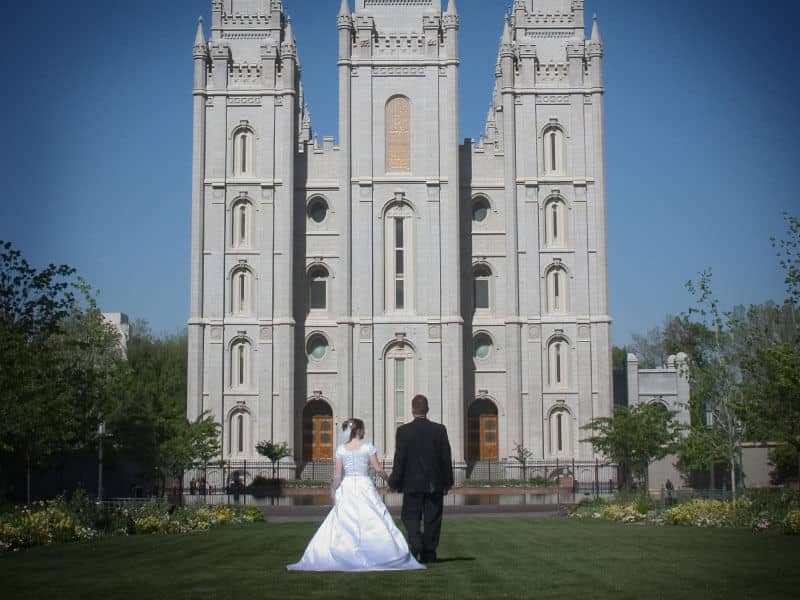At the Hyde Park First Ward in Chicago's predominantly black South Side, the speakers--one white, one black--were from Utah. They were Margaret Blair Young and Darius Gray, co-authors of fictionalized accounts of the joys and difficulties of the earliest black Mormons. Volume one, "One More River to Cross," and volume two, "Bound for Canaan," will be joined in May by the final book of the trilogy, "The Last Mile of the Way," from Deseret Books.
After a moving version of the spiritual "I Couldn't Hear Nobody Cry" sung by an all-white choir, Young shared the stories of two real African-American Latter-day Saints. In Salt Lake City around 1900, eight-year-old Abner Howell was told by jeering Mormon boys, "Don't you know you can't get into heaven because you're black?" An apostle, John Henry Smith (father of future LDS Church president George Albert Smith), consoled Ab, telling him that those boys were wrong. He showed Ab a passage from the Book of Mormon: [The Lord] denieth none that come unto him, black and white, bond and free, male and female...and all are alike unto God." (2 Nephi 26:33)
Another black man, Len Hope, became a Mormon in Alabama in the 1919, right after World War I. When he and his family moved to Cincinnati, the "Saints" in the local congregation told their bishop that if a black family was going to come, they would all leave. The bishop told the Hopes not to attend, except for quarterly district meetings when they could pay their tithing. He sent missionaries to take them the sacrament of the Lord's supper once a month.
Darius Gray shared details of the founding of the Genesis Group. In 1971, Gray and two other black Latter-day Saints (Ruffin Bridgeforth and Eugene Orr) met in Salt Lake City to see if there was anything they could do to stem black attrition in Mormon membership. (When Gray joined the Church in 1964, there were only between 300 and 400 black members.) The men approached Church President Joseph Fielding Smith for help. President Smith assigned three of the newest apostles to meet regularly with the three men to discuss racial issues in the Church.
After months of scheduled sessions, the three black men were called to an unscheduled meeting. The apostles--Gordon B. Hinckley, Thomas S. Monson, and Boyd K. Packer--told them that the President of the Church had made a decision. Gray and his two friends were called to be the presidency of an authorized arm of the LDS church to provide spiritual, social, and emotional support to all black Latter-day Saints.
That group--'The Genesis Group'--has flourished since then. "Everyone is welcome. It provides a place where kids of all colors can see black men and women in positions of leadership," said Pres. Gray. Then with a wink he added, "And we only ask 7.5% for tithing."
Meeting the first Sunday of every month in Salt Lake City as a supplement to members' regular church services, The Genesis Group holds worship meetings for people of all color (including white) and offers a free newsletter to anyone requesting the service. (Contact LDSgenesis@aol.com )
In a Q&A period, someone asked the prickly question, "Why was there a restriction put on blacks holding the priesthood in the first place?
President Gray responded by asking the audience to share reasons they had heard for the ban. Their list included "Blacks bear the curse of Cain," "White members of the Church weren't prepared," "Blacks were less valiant in the pre-existence" (the teaching that all people existed as spirits before coming to earth in bodies), and more. The list was still growing when Pres. Gray said, "All those reasons you've heard? None of them is right. All of them are speculations. Why was there a ban on blacks holding the priesthood? We don't know. That's the official Church answer."
Chicagoan Cathy Stokes, a black leader in the Hyde Park Ward, added, "Race has been an issue in American life since the first slaves got off the boat. Every religion deals with it. Our questions should be 'what are we doing now?' 'how are we addressing the issue?' We need to ask for the guidance of the Spirit in that task. We need to keep our eye on the doughnut and not on the hole."
Pres. Gray said, "We are products of our Creator. God made our differences. Satan's goal is to divide us. God's plan is unity. Issues of race are with us. If we acknowledge and admit that there are problems, we have the possibility of healing. We can dispel myths about the Church among blacks and educate whites. There is misinformation on both sides. The stories of early black pioneers teach us about being well prepared for the future. We're still pioneers."
Light or shadow? Either way, Spring is ahead - and there's plenty of work to do before we get there.

